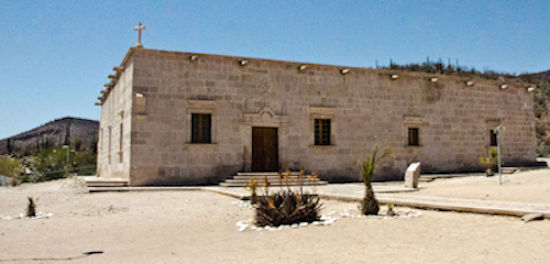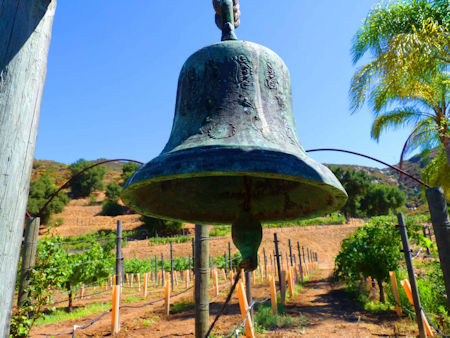 |  |
By Greg Niemann

Much has been written lately about the fine wine and vineyards of Valle de Guadalupe near Ensenada. But it was a Baja California mission outpost far to the south that is credited as the birthplace of Baja California’s wine industry.
In fact, all California wine, even that of the world-renown Napa Valley, can trace its roots to Mexico’s missional system. That unlikely birthplace of the California wine industry is the remote Baja California Mission of Santa Gertrudis la Magna where wine experimentation began to produce quality wine in 1752.
Santa Gertrudis is unique for several other reasons as well; it was the first mission established in the present state of Baja California (Norte); for 10 years it served as headquarters and outpost for exploration to the north; and the graceful stone church in a peaceful setting makes it one of the most attractive Baja missions today.
Located 23 miles east into the desert from El Arco, Santa Gertrudis is just north of the 28th parallel which separates Mexico’s two peninsular states.
Mission Santa Gertrudis was named in honor of Dona Gertrudis de la Pena, wife of the Marquis de Villapuente. They donated funds stipulating that they must be used to establish a mission dedicated to Saint Gertrudis in the land of the Cochimis.
The site for the mission was discovered in 1751 by Jesuit Padre Fernando Consag. He established preliminary work on what was originally called Dolores del Norte, before the name was changed to honor St. Gertrudis. He placed the construction of simple buildings under the guidance of a blind Cochimi Indian, Andres Comanaji Sistiaga (or Sestiaga), who was amazing in his accomplishments in spite of his handicap.
The walls of mud and small stones supported a roof constructed of timbers across which were laid reeds or rules. As it rarely rained and the Indians preferred to sleep outside, these rough buildings sufficed in the beginning.

Dedicated in 1752
The mission was not formally opened until 1752. Padre Consag died and Padre Jorge Retz, a robust German Jesuit priest, was sent there after spending a year in San Ignacio to learn the Cochimi language.
According to custom the other missions contributed whatever could be spared of provision, cattle, horses, mules, sheep and goats for the new mission. Padre Retz, also ably assisted by the blind Indian, built a substantial building of stone and lime mortar.
Padre Retz soon found himself in charge of 1,400 Indians who had agreed to be baptized in this strange European religion. Some estimates indicate there were as many as 3,000 Indians living in the mission area during its heyday. Retz discovered a reliable spring and cut a canal from solid rock 1½ miles to a small field that could be farmed after hauling in topsoil.
This small aqueduct is still in evidence today; in fact just before arriving at the mission, the road crosses the narrow canal which is covered by large, loosely lain pieces of stone. I noted the water appeared fresh and ran freely from its ancient waterway.
California’s First Wine Industry
Padre Retz and his charges grew and harvested wheat and corn. They planted date palms, olive trees, fig trees, peaches and pomegranates, along with the significant grapevines.
According to Arthur Walbridge North in his 1908 book The Mother of California, “Padre Retz, an industrious German Jesuit, planted grapevines in this garden, after having enriched its soil with fine loam brought from distant arroyos. Later, he made from the grapes of Santa Gertrudis such excellent wine that he ranks as the first California winemaker.”
Earlier peninsula Jesuits had been making sacramental wine at a few other missions, some of it quite good and used for trading. The first recorded planting of a vineyard in the Californias was by the Spanish Jesuit Padre Eusebio Kino at the short-lived San Bruno mission near Loreto in 1683.
Loreto became the peninsula’s first sustained mission in 1697, but it was Jesuit Padre Juan de Ugarte, who in 1701, while making California’s second mission of San Javier (1699) a model outpost, cultivated California’s first grapevines and press.
Among his many accomplishments he established schools, brought sheep and goats from the Mexican mainland, cleared land for orchards, and imported olives, pomegranates, figs, and citrus. He learned that the most valuable crops were figs and grapes because they yielded dried fruit and wine which could be pressed and handily stored or transported for trade.
Early Baja wines were made from the mission grape, a common red vinifera variety from Europe, presumably from Spain, with a somewhat fruity taste. That variety dominated California wine production until about 1880.

Cuttings were then transferred from established missions to the newer ones. San Ignacio mission (1728) for example, with its secure water supply, became the most prolific supplier of mission wine for many years.
Then in 1791 wine production increased when Mission Santo Tomas was established in a fertile valley 26 miles south of Ensenada. That region afforded the perfect vineyard climate, and by year 1800 there were 5,000 vines there, eventually giving birth to Mexico’s oldest commercial winery, the Bodegas de Santo Tomas (1888).
Today over 90 percent of Mexico’s wine is produced in the Ensenada region which includes the Valle de Guadalupe. The over 30 wineries that have developed since the 1970s have found that numerous other varieties do well too, including some fine merlots and syrahs. However, some of those original mission grapes are still in existence, even producing wine today in the Valle de Guadalupe.
The Little Old Winemaker
While Padre Ugarte was the first to plant a grapevine and press for wine, it was still Retz who is still referred to as the first California winemaker because he produced such an excellent wine at Santa Gertrudis.
TCasks being unknown there, Padre Retz designed containers hewn from blocks of stone. He filled them with the juice of the grapes, then covered them with boards and sealed them with a gum from the pitahaya plant. This ingenuity and care resulted in California’s finest wine at the time.
Franciscan Padre Junipero Serra, who established nine California missions, planted the first sustained vineyard in the U.S. state of California at Mission San Diego in 1779. For that he has sometimes has been called the “Father of California Wine.”
Several padres from the missional system were instrumental in developing the California wine industry (Kino, Ugarte, Retz, Serra, and others). But the advancements made by Padre Retz at Santa Gertrudis were extraordinary.
Center for Exploration

Perched on a ledge in a small arroyo, Santa Gertrudis became the center of the frontier region and base for further exploration until San Borja was founded 10 years later.
Life at Santa Gertrudis apparently agreed with Padre Retz because it is said that he was a rather corpulent man. He was also somewhat infirm and, at best, had difficulty traveling. When the Jesuits were expelled from Baja California in 1768, Retz had a severely injured foot. So he had teams of his mission Indians hand-carry him 200 miles to the ship at Loreto.
That year the Dominicans arrived, completing the present stone church in 1796. They also built a campanile or belfry separate from the church.
Irrigation System Still in Use
Date palms are in evidence near the mission, and you can see portions of the 250+ year aqueduct. Cattle and horses bask around the small pond near its terminus.
While the earlier adobe buildings have been reduced to crumbling walls, the mission chapel and belfry are in splendid condition. Thick stone walls render a cool interior which still has one room used as a chapel, and another set aside as a crude museum, complete with an original tabernacle in a glass case, an old crucifix, and simple models of the church made by local children. There is a small container for donations.
The Santa Gertrudis Indian population suffered greatly from diseases. By 1785 there were only 300 Indians. By 1822, the mission was finally abandoned due to a dwindling Indian population of fewer than 100. The mission was extensively remodeled in 1997.
Today the quiet arroyo is home to a few hardy families who still use a portion of the over two-century-old irrigation system. They tend the dwindling old historic grapevines, olive trees, and date palms along with their own crops.
The birthplace of California’s world-class wine industry is a picturesque gem: a palm oasis surrounded by desert chaparral, cacti, and the indigenous cirio (boojum) tree. Colorful mountain cliffs stand guard over one of the better preserved and more attractive of Baja California’s missions. It was so idyllic, even the little old winemaker Padre Jorge Retz had to be carried out of there.
How to get there:
Highway 1 to Guerrero Negro (444 miles south of Tijuana); 17 miles south on Highway 1 to El Arco cutoff; 25 miles to El Arco; marked sign to Santa Gertrudis 23 miles away; road is good for first 17 miles, then has high crown and is rocky.
About Greg
Greg Niemann, a long-time Baja writer, is the author of Baja Fever, Baja Legends, Palm Springs Legends, Las Vegas Legends, and Big Brown: The Untold Story of UPS. Visit www.gregniemann.com.

very easy interface.

Easy to renew, offers the best coverage for me to feel comfortable while driving in Mexico.

Great insurance policy experience for our Mexico travels